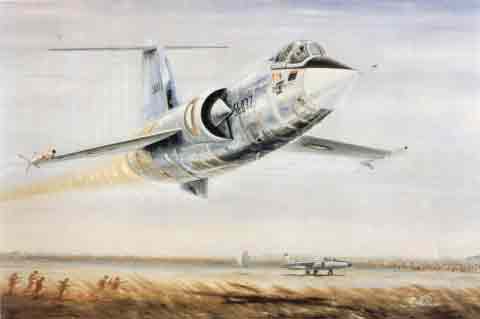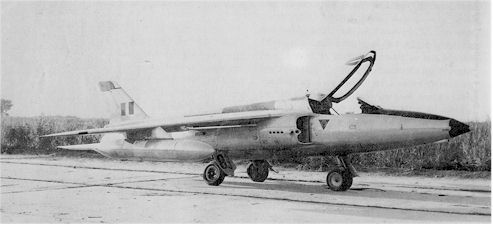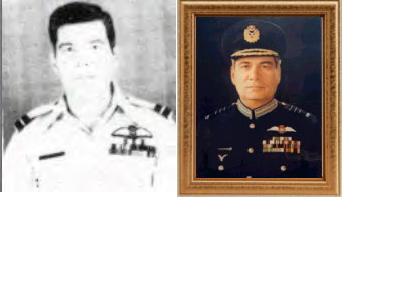
PAKISTAN AIR FORCE Second to none
C-130 as B-130
P A F Photo Page
Pak Commandos
Pakistan 4 India 0
Bye Bye Pathankot
Gnat Surrenders
Sargodha 7th Sep 1965
Gurdas Pur Train Blast
|
 |
|
IAF Surrenders Sep 1965

A Gnat Surrenders While this battle of wits between the Sabres, Gnats and the single F-104 was going on, Sakesar had scrambled another F-104 to the scene, Flown by Flight Lieutenant Hakimullah, it arrived in time to take part, together with the other F-104, in forcing down a Gnat which had strayed from its main formation, and had to contend with 2 F-104s at uncomfortably close quarters. Finding himself over an abandoned airfield (Pasrur), Squadron Leader Brij Pal Singh Sikand seeing no other way out of his predicament, immediately landed his Gnat to save his skin. F/L Hakimullah circled overhead until the capture of the aircraft and the pilot was assured by Pakistani troops. Although the F-104s had no direct success so far, it was evident that the IAF had a very healthy regard for its capabilities. The pilot of the captured Gnat - who happened to be the squadron commander, and who was to be dismissed by the IAF while still in captivity stated that he had only the night before arrived at Halwara from Ambala. After refuelling at Pathankot, his formation of six Gnats were assigned that morning to provide close support for Indian Army troops in the Bhimber area. This, of course, had been frustrated by the determined action of the outnumbered PAF pilots, after which the IAF Gnat pilot claimed that be had lost his radio and compass, and that his two 30mm cannon had jammed. The Indian prisoner, also bet the PAF pilot assigned to fly the Gnat away from Pasrur that he would not be able to start the aircraft, let alone get it airborne. What the Indian pilot did not know however, was that Sqn Ldr S. A. Hatmi of the PAF had flown Gnat Trainers extensively with the RAF, and the differences from the AL-built fighter version were sufficiently minor to present him few problems. When the Gnat flew into Sargodha three days after landing at Pasrur, with an escort of six Sabres, it was greeted with acclamation, and its few secrets were soon laid bare, although a tactical evaluation was not possible until after the end of hostilities. It was recognised as an effective little aircraft, although with limited range and an inferior turning circle to the Sabre. As for its muchboosted reputation as 'Sabre-Slayer'. it seems that in this respect, the Indians appear to have been victims of their own propaganda. Certainly the Gnat was regarded by the PAF with less respect than the Hunter. Nor is the PAF convinced that it lost more than one or two Sabres to Gnats throughout the entire period of hostilities with India. Meanwhile Gnat No IE 1083 is still hangared at Sargodha as a treasured momento to the PAF's moral superiority over the IAF. And when its guns were tested immediately after its capture, they worked perfectly ¦
|
| |
Indian Version
Keelor became the first Indian pilot to shoot down a jet in air to air combat. The Sabre was armed with the sidewinder missiles, which makes the feat even more remarkable. It was the first time that the Gnat fired its guns in anger. it was previously untested in combat.
But the fight was not over yet. While Keelor was dealing with the Sabre, Pathania spotted two more Sabres and engaged them even as a F-104 Starfighter was noticed up above. The Starfighter broke Pathania's attack on the Sabre and even as the Indian Pilots regrouped, would engage reheat to fly away from the area. Murdeshwar had to go through the frustration of not being able to warn Pathania of the incoming F-104 Starfighter due to his R/T becoming snagged. He had noticed that while he was receiving incoming transmissions, he could not transmit himself thus was unable to warn Pathania about the Starfighter.
Fg. Off. Krishnaswamy at one point of the combat found the Starfighter on his tail, then overshoot him and present him with a nice target, but as Krishnaswamy later admitted, he was so awestruck at the sight of the sleek and beautiful fighter that he forgot to open fire. The Gnats were now getting short on fuel, and they rendezvoused to fly back to base.
It was back at base amidst the celebrations that they discovered that Sikand was missing. Initially it was thought that Sikand must have been lost in air combat. In fact unknown to the Indian Pilots, Sikand had lost contact with the formation as well as his bearings. Most aircraft at that time did not have radars, or GPS systems or navigational aids. All the pilots had to use their maps and the aircraft compass to do their navigation back to base using visible landmarks.
Gnat was low on fuel, and over unfamiliar territory, and after some flying Sikand found an airfield and in a foolish decision decided to land there. Sikand was under the impression that this was an abandoned airfield in Indian territory. But he should have known better that there were not many such airfields. Ultimately after he landed to his rude shock found out that the airfield was the Pakistani airfield of Pasrur. But before he could recover from the shock, he was taken POW and the aircraft was captured.
After the aircraft was captured, it was flown to Peshawar by Flt. Lt. Saad Hatmi of the PAF, who had previous experience on Gnats during a stint in U.K. The aircraft was flight tested thoroughly by the PAF. The Pakistanis claim that Sikand surrendered and landed at Pasrur after being intercepted by a Starfighter flown by Flt. Lt. Hakimullah. India had always maintained that Sikand landed the Gnat at Pasrur by mistake thinking it was Pathankot, but not much has come to light in this regard after that. While it is true that Hakimullah was in the same area as the Gnat was, it is conjecture to say that Hakimullah forced Sikand to land at Pasrur. Sikand later went on to become a Air Marshal in the Indian Air Force even earning a AVSM, which seems to suggest that it was more a mistake than a deliberate act of surrender as the Pakistanis would have everyone believe. Today Gnat IE 1083 is on display at the PAF Museum at Karachi.
|
 Squadron Leader Brijpal Singh Sikand, Commander of an Indian fighter squadron, surrenders to a PAF F-104 in combat. The painting shows him landing his Gnat fighter at Pasrur, a Pakistani airfield near Gujranwala. The F-104 was flown by Flight Lieutenant Hakimullah who became the Air Chief two decades later. Sikand was taken prisonar and later rose to be an IAF Air Marshal. This encounter was the most unusual event of the 1965 Air War.
Squadron Leader Brijpal Singh Sikand, Commander of an Indian fighter squadron, surrenders to a PAF F-104 in combat. The painting shows him landing his Gnat fighter at Pasrur, a Pakistani airfield near Gujranwala. The F-104 was flown by Flight Lieutenant Hakimullah who became the Air Chief two decades later. Sikand was taken prisonar and later rose to be an IAF Air Marshal. This encounter was the most unusual event of the 1965 Air War.
|
| |
Air Chief Marshal Hakimullah HI(M), SJ
General
Date of Birth: 15 Oct, 1935
Date of Commission: Jan, 1957
Period as CAS: 9th Mar, 1988 to 9th Mar, 1991
Key Command & Staff Appointments
* Officer Commanding No 5 Squadron
* Officer Commanding No 33 Wing
* Officer Commanding Combat Commanders School Sargodha
* Base Commander Rafiqui
* Director of Operations
* Assistant Chief of the Air Staff (Flight Safety)
* Chief Inspector
* Senior Air Staff Officer, Air Defence Command
* Assistant Chief of the Air Staff (Operations)
* Deputy Chief of the Air Staff (Operations)
* Deputy Chief of the Air Staff (Administration)
Courses
* Fighter Leader School Course Mauripur (Masroor)
* Air Command and Staff Studies Course, USA
* Royal College of Defence Studies Course, UK
|
 SIKKY's Gnat: Sqn Ldr Brijpal Singh Sikand, of No.23 Gnats Squadron forcelanded his Gnat at Pasrur on September 3rd, His aircraft was captured intact by the Pakistanis and testflown extensively much later at Peshawar. This aircraft is on display at the Karachi PAF Museum today.
SIKKY's Gnat: Sqn Ldr Brijpal Singh Sikand, of No.23 Gnats Squadron forcelanded his Gnat at Pasrur on September 3rd, His aircraft was captured intact by the Pakistanis and testflown extensively much later at Peshawar. This aircraft is on display at the Karachi PAF Museum today.
|
| |
In 1965 there can be no argument that the PAF pilots were much superior horsemen in every way to those of the Indian Air Force. By 23 September when the war ended, India had lost 110 aircrafts and damaged nineteen, not including those destroyed on the ground at night - against 16 PAF planes. Of the 110, thirty-five were brought down by the Army ground fire. PAF could also claim the destruction of 149 tanks, more than 600 heavy vehicles including troop carriers, and sixty artillery guns. To corroborate its claims, after the cease-fire the PAF invited newsmen to visit bases where their squadrons were lined up, ready to be counted. Pakistan's Air Marshal Nur Khan even invited his Indian counterpart, Air Marshal Arjun Singh, to come along and see for himself. The invitation was not accepted |
 Again in 1971
Again in 1971
Wing Commander
Hakimullah
Sitara-i-Juraat
Wing Commander Hakimullah was commanding a fighter bomber squadron during the Indo-Pakistan War, 1971. He led five strike missions against heavily defended enemy airfields. Every mission, led by him, including the first strike against Amritsar, was flown with tremendous courage and exceptional professional skill. He flew with nerve and cool composure, which was a source of inspiration to his team in particular and everyone else connected with operational activity in general. During some of these strikes his formation was intercepted by enemy fighters over Indian airfields. Wing Commander Hakimullah lived upto the highest traditions of leadership during these critical moments and accomplished the primary mission. Throughout the war, his unit inspired by him, flew boldly and without any losses in aircraft or pilot. For his gallant and professional performance, He has been awarded Sitara-i-Juraat.
|
|